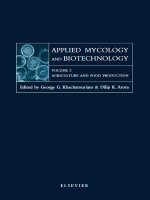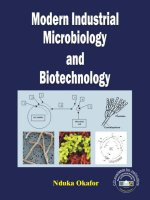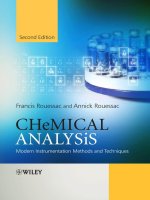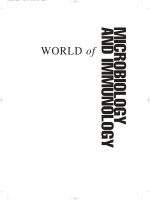modern industrial microbiology and biotechnology
Bạn đang xem bản rút gọn của tài liệu. Xem và tải ngay bản đầy đủ của tài liệu tại đây (7.03 MB, 551 trang )
Modern Industrial
Microbiology and Biotechnology
Modern Industrial
Microbiology and Biotechnology
Modern Industrial
Microbiology and Biotechnology
Nduka Okafor
Department of Biological Sciences
Clemson University, Clemson
South Carolina
USA
Science Publishers
Enfield (NH) Jersey Plymouth
SCIENCE PUBLISHERS
An imprint of Edenbridge Ltd., British Isles.
Post Office Box 699
Enfield, New Hampshire 03748
United States of America
Website:
sales @scipub.net (marketing department)
(editorial department)
(for all other enquiries)
Library of Congress Cataloging-in-Publication Data
Okafor, Nduka.
Modern industrial microbiology and bitechnology/Nduka Okafor.
p. cm.
Includes bibliographical references and index.
ISBN 978-1-57808-434-0(HC)
ISBN 978-1-57808-513-2(PB)
1. Industrial microbiology. 2. Biotechnology. I. Title
QR53.O355 2007
660.6’2 dc22
2006051256
ISBN 978-1-57808-434-0 (HC)
ISBN 978-1-57808-513-2 (PB)
© 2007, Nduka Okafor
All rights reserved. No part of this publication may be reproduced, stored in
a retrieval system, or transmitted in any form or by any means, electronic,
mechanical, photocopying, recording or otherwise, without the prior
permission.
This book is sold subject to the condition that it shall not, by way of trade or
otherwise, be lent, re-sold, hired out, or otherwise circulated without the
publisher’s prior consent in any form of binding or cover other than that in
which it is published and without a similar condition including this
condition being imposed on the subsequent purchaser.
Published by Science Publishers, Enfield, NH, USA
An imprint of Edenbridge Ltd.
Printed in India.
Dedication
This book is dedicated to the Okafor-Ozowalu family of Nri,
Anambra State, Nigeria, and their inlaws.
Modern Industrial
Microbiology and Biotechnology
The field of industrial microbiology has been undergoing rapid change in recent years.
First, what has been described as the ‘cook book’ approach has been largely abandoned
for the rational manipulation of microorganisms on account of our increased knowledge
of their physiology. Second, powerful new tools and technologies especially genetic
engineering, genomics, proteomics, bioinformatics and such like new areas promise
exciting horizons for man’s continued exploitation of microorganisms. Third, new
approaches have become available for the utilization of some traditional microbial
products such as immobilized enzymes and cells, site-directed mutation and metabolic
engineering. Simultaneously, microbiology has addressed itself to some current
problems such as the fight against cancer by the production of anti-tumor antibiotics; it
has changed the traditional practice in a number of areas: for example the deep sea has
now joined the soil as the medium for the search for new bioactive chemicals such as
antibiotics. Even the search for organisms producing new products has now been
broadened to include unculturable organisms which are isolated mainly on genes
isolated from the environment. Finally, greater consciousness of the effect of fossil fuels
on the environment has increased the call in some quarters for the use of more
environmentally friendly and renewable sources of energy, has led to a search for
alternate fermentation substrates, exemplified in cellulose, and a return to fermentation
production of ethanol and other bulk chemicals. Due to our increased knowledge and
changed approach, even our definitions of familiar words, such as antibiotic and species
seem to be changing. This book was written to reflect these changes within the context of
current practice.
This book is directed towards undergraduates and beginning graduate students in
microbiology, food science and chemical engineering. Those studying pharmacy,
biochemistry and general biology will find it of interest. The section on waste disposal
will be of interest to civil engineering and public health students and practitioners. For
the benefit of those students who may be unfamiliar with the basic biological
assumptions underlying industrial microbiology, such as students of chemical and civil
engineering, elements of biology and microbiology are introduced. The new elements
which have necessitated the shift in paradigm in industrial microbiology such as
bioinformatics, genomics, proteomics, site-directed mutation, metabolic engineering, the
human genome project and others are also introduced and their relevance to industrial
Preface
LEEE Modern Industrial Microbiology and Biotechnology
microbiology and biotechnology indicated. As many references as space will permit are
included.
The various applications of industrial microbiology are covered broadly, and the
chapters are grouped to reflect these applications. The emphasis throughout, however, is
on the physiological and genomic principles behind these applications.
I would like to express my gratitude to Professors Tom Hughes and Hap Wheeler
(Chairman) of the Department of Biological Sciences at Clemson University for their help
and encouragement during the writing of the book. Prof Ben Okeke of Auburn University,
Alabama, and Prof Jeremy Tzeng of Clemson University read portions of the script and I
am deeply grateful to them.
My wife, Chinyelu was a source of constant and great support, without which the
project might never have been completed. I cannot thank her enough.
Clemson, South Carolina Nduka Okafor
Contents EN
Preface vii
SECTION A INTRODUCTION
1. Introduction: Scope of Biotechnology and
Industrial Microbiology 3
1.1 Nature of Biotechnology and Industrial Microbiology 3
1.2 Characteristics of Industrial Microbiology 4
1.2.1 Industrial vs medical microbiology 4
1.2.2 Multi-disciplinary or Team-work nature of
industrial microbiology 4
1.2.3 Obsolescence in industrial microbiology 5
1.2.4 Free communication of procedures in industrial microbiology 5
1.3 Patents and Intellectual Property Rights in
Industrial Microbiology and Biotechnology 5
1.4 The Use of the Word ‘Fermentation’ in Industrial Microbiology 9
1.5 Organizational Set-up in an Industrial Microbiology Establishment 10
Suggested Readings 13
SECTION B BIOLOGICAL BASIS OF PRODUCTIVITY IN
INDUSTRIAL MICROBIOLOGY AND BIOTECHNOLOGY
2. Some Microorganisms Commonly Used in
Industrial Microbiology and Biotechnology 17
2.1 Basic Nature of Cells of Living Things 17
2.2 Classification of Living Things: Three Domains of Living Things 18
2.3 Taxonomic Grouping of Micro-organisms Important in
Industrial Microbiology and Biotechnology 19
2.3.1 Bacteria 21
2.3.2 Eucarya: Fungi 29
2.4 Characteristics Important in Microbes Used in
Industrial Microbiology and Biotechnolgy 31
Suggested Readings 33
Contents
N Modern Industrial Microbiology and Biotechnology
3. Aspects of Molecular Biology and Bioinformatics of
Relevance in Industrial Microbiology and Biotechnology 34
3.1 Protein Synthesis 34
3.2 The Polymerase Chain Reaction 39
3.2.1 Some applications of PCR in industrial microbiology and
biotechnology 41
3.3 Microarrays 42
3.3.1 Applications of microarray technology 43
3.4 Sequencing of DNA 44
3.4.1 Sequencing of short DNA fragments 44
3.4.2 Sequencing of genomes or large DNA fragments 46
3.5 The Open Reading Frame and the Identification of Genes 46
3.6 Metagenomics 48
3.7 Nature of Bioinformatics 50
3.7.1 Some contributions of bioinformatics to biotechnology 51
Suggested Readings 52
4. Industrial Media and the Nutrition of Industrial Organisms 54
4.1 The Basic Nutrient Requirements of Industrial Media 54
4.2 Criteria for the Choice of Raw Materials Used in Industrial Media 56
4.3 Some Raw Materials Used in Compounding Industrial Media 58
4.4 Growth Factors 62
4.5 Water 62
4.6 Some Potential Sources of Components of Industrial Media 63
4.6.1 Carbohydrate sources 63
4.6.2 Protein sources 65
4.7 The Use of Plant Waste Materials in Industrial Microbiology Media:
Saccharification of Polysaccharides 66
4.7.1 Starch 67
4.7.2 Cellulose, hemi-celluloses and lignin in plant materials 73
Suggested Readings 76
5. Metabolic Pathways for the Biosynthesis of
Industrial Microbiology Products 77
5.1 The Nature of Metabolic Pathways 77
5.2 Industrial Microbiological Products as Primary and Secondary Metabolites 78
5.2.1 Products of primary metabolism 78
5.2.2 Products of secondary metabolism 79
5.3 Trophophase-idiophase Relationships in the Production of
Secondary Products 81
5.4 Role of Secondary Metabolites in the Physiology of
Organisms Producing Them 82
5.5 Pathways for the Synthesis of Primary and Secondary Metabolites of
Industrial Importance 83
5.5.1 Catabolism of carbohydrates 84
5.5.2 The Catabolism of hydrocarbons 88
Contents NE
5.6 Carbon Pathways for the Formation of Some
Industrial Products Derived from Primary Metabolism 89
5.6.1 Catabolic products 89
5.6.2 Anabolic products 89
5.7 Carbon Pathways for the Formation of Some Products of
Microbial Secondary Metabolism of Industrial Importance 89
Suggested Readings 98
6. Overproduction of Metabolites of Industrial Microorganisms 99
6.1 Mechanisms Enabling Microorganisms to Avoid Overproduction of
Primary Metabolic Products Through Enzyme Regulation 100
6.1.1 Substrate induction 101
6.1.2 Catabolite regulation 103
6.1.3 Feedback regulation 105
6.1.4 Amino acid regulation of RNA synthesis 107
6.1.5 Energy charge regulation 107
6.1.6 Permeability control 108
6.2 Derangement or Bypassing of Regulatory Mechanisms for
the Over-production of Primary Metabolites 109
6.2.1 Metabolic control 109
6.2.2 Permeability 114
6.3 Regulation of Overproduction in Secondary Metabolites 115
6.3.1 Induction 115
6.3.2 Catabolite regulation 115
6.3.3 Feedback regulation 117
6.3.4 ATP or energy charge regulation of secondary metabolites 117
6.4 Empirical Methods Employed to Disorganize Regulatory
Mechanisms in Secondary Metabolite Production 120
Suggested Readings 120
7. Screening for Productive Strains and Strain
Improvement in Biotechnological Organisms 122
7.1 Sources of Microorganisms Used in Biotechnology 122
7.1.1 Literature search and culture collection supply 122
7.1.2 Isolation de novo of organisms producing
metabolites of economic importance 123
7.2 Strain Improvement 125
7.2.1 Selection from naturally occurring variants 126
7.2.2 Manipulation of the genome of
industrial organisms in strain improvement 126
Suggested Readings 170
8. The Preservation of the Gene Pool in
Industrial Organisms: Culture Collections 171
8.1 The Place of Culture Collections in
Industrial Microbiology and Biotechnology 171
8.2 Types of Culture Collections 172
NEE Modern Industrial Microbiology and Biotechnology
8.3 Handling Culture Collections 173
8.4 Methods of Preserving Microorganisms 173
8.4.1 Microbial preservation methods based on the
reduction of the temperature of growth 174
8.4.2 Microbial preservation methods based on dehydration 176
8.4.3 Microbial preservation methods based on the
reduction of nutrients 178
8.4.4 The need for experimentation to determine the
most appropriate method of preserving an organism 178
Suggested Redings 178
SECTION C BASIC OPERATIONS IN INDUSTRIAL FERMENTATIONS
9. Fermentors and Fermentor Operation 183
9.1 Definition of a Fermentor 183
9.2 The Aerated Stirred Tank Batch Fermentor 184
9.2.1 Construction materials for fermentors 185
9.2.2 Aeration and agitation in a fermentor 185
9.2.3 Temperature control in a fermentor 186
9.2.4 Foam production and control 188
9.2.5 Process control in a fermentor 192
9.3 Anerobic Batch Fermentors 195
9.4 Fermentor Configurations 196
9.4.1 Continuous fermentations 196
9.5 Fed-batch Cultivation 202
9.6 Design of New Fermentors on the
Basis of Physiology of the Organisms: Air Lift Fermentors 202
9.7 Microbial Experimentation in the Fermentation Industry:
The Place of the Pilot Plant 205
9.8 Inoculum Preparation 205
9.9 Surface or Solid State Fermentors 206
Suggested Readings 206
10. Extraction of Fermentation Products 208
10.1 Solids (Insolubles) Removal 209
10.1.1 Filtration 209
10.1.2 Centrifugation 210
10.1.3 Coagulation and flocculation 210
10.1.4 Foam fractionation 211
10.1.5 Whole-broth treatment 212
10.2 Primary Product Isolation 212
10.2.1 Cell disruption 212
10.2.2 Liquid extraction 213
10.2.3 Dissociation extraction 214
10.2.4 Ion-exchange adsorption 214
10.2.5 Precipitation 216
Contents NEEE
10.3 Purification 217
10.3.1 Chromatography 217
10.3.2 Carbon decolorization 217
10.3.3 Crystallization 218
10.4 Product Isolation 218
10.4.1 Crystalline processing 218
10.4.2 Drying 218
Suggested Readings 220
11. Sterility in Industrial Microbiology 221
11.1 The Basis of Loss by Contaminants 221
11.2 Methods of Achieving Sterility 222
11.2.1 Physical methods 222
11.2.2 Chemical methods 227
11.3 Aspects of Sterilization in Industry 229
11.3.1 The sterilization of the fermentor and its accessories 229
11.3.2 Media sterilization 229
11.4 Viruses (Phages) in Industrial Microbiology 230
11.4.1 Morphological grouping of bacteriophages 232
11.4.2 Lysis of hosts by phages 232
11.4.3 Prevention of phage contamination 232
11.4.4 Use of phage resistant mutants 234
11.4.5 Inhibition of phage multiplication with chemicals 234
11.4.6 Use of adequate media conditions and other practices 234
Suggested Readings 234
SECTION D ALCOHOL-BASED FERMENTATION INDUSTRIES
12. Production of Beer 237
12.1 Barley Beers 237
12.1.1 Types of barley beers 237
12.1.2 Raw materials for brewing 238
12.1.3 Brewery processes 242
12.1.4 Beer defects 253
12.1.5 Some developments in beer brewing 255
12.2 Sorghum Beers 258
12.2.1 Kaffir beer and other traditional sorghum beers 258
Suggested Readings 260
13. Production of Wines and Spirits 262
13.1 Grape Wines 262
13.1.1 Processes in wine making 262
13.1.2 Fermentation 263
13.1.3 Ageing and storage 263
13.1.4 Clarification 264
13.1.5 Packaging 265
NEL Modern Industrial Microbiology and Biotechnology
13.1.6 Wine defects 265
13.1.7 Wine preservation 265
13.1.8 Classification of wines 265
13.2 Palm Wine 270
13.3 The Distilled Alcoholic (or Spirit) Beverages 274
13.3.1 Measurement of the alcoholic strength of distilled beverages 274
13.3.2 General principles in the production of spirit beverages 275
13.3.3 The spirit beverages 276
Suggested Readings 278
14. Production of Vinegar 280
14.1 Uses 280
14.2 Measurement of Acetic Acid in Vinegar 281
14.3 Types of Vinegar 281
14.4 Organisms Involved 282
14.5 Manufacture of Vinegar 283
14.5.1 The Orleans (or slow) method 283
14.5.2 The trickling generators (quick) method 284
14.5.3 Submerged generators 286
14.6 Processing of Vinegar 288
Suggested Readings 289
SECTION E USE OF WHOLE CELLS FOR FOOD RELATED PURPOSES
15. Single Cell Protein (SCP) 293
15.1 Substrates for Single Cell Protein Production 294
15.1.1 Hydrocarbons 294
15.1.2 Alcohols 297
15.1.3 Waste products 298
15.2 Microorganisms Used in SCP Production 300
15.3 Use of Autotrophic Microorganisms in SCP Production 300
15.4 Safety of Single Cell Protein 303
15.4.1 Nucleic acids and their removal from SCP 304
15.5 Nutritional Value of Single Cell Protein 305
Suggested Readings 305
16. Yeast Production 306
16.1 Production of Baker’s Yeast 306
16.1.1 Yeast strain used 308
16.1.2 Culture maintenance 309
16.1.3 Factory production 309
16.2 Food Yeasts 311
16.2.1 Production of food yeast 312
16.3 Feed Yeasts 313
16.4 Alcohol Yeasts 314
Contents NL
16.5 Yeast Products 314
Suggested Readings 314
17. Production of Microbial Insecticides 315
17.1 Alternatives to Chemical Insecticides 315
17.2 Biological Control of Insects 316
17.2.1 Desirable properties in organisms to be used for
biological control 317
17.2.2 Candidates which have been considered as
biological control agents 318
17.2.3 Bacillus thuringiensis Insecticidal toxin 321
17.3 Production of Biological Insecticides 322
17.3.1 Submerged fermentations 322
17.3.2 Surface culture 323
17.3.3 In vivo culture 323
17.4 Bioassay of Biological Insecticides 323
17.5 Formulation and Use of Bioinsecticides 324
17.5.1 Dusts 324
17.5.2 Liquid formulation 324
17.6 Safety Testing of Bioinsecticides 325
17.7 Search and Development of New Bioinsecticides 325
Suggested Readings 326
18. The Manufacture of
Rhizobium
Inoculants 327
18.1 Biology of Rhizobium 328
18.1.1 General properties 328
18.1.2 Cross-inoculation groups of rhizobium 328
18.1.3 Properties desirable in strains to be selected for
use as rhizobium inoculants 328
18.1.4 Selection of strains for use as rhizobial inoculants 329
18.2 Fermentation of Rhizobia 330
18.3 Inoculant Packaging for Use 331
18.3.1 Seed inoculants 331
18.3.2 Soil inoculants 332
18.4 Quality Control 333
Suggested Readings 333
19. Production of Fermented Foods 334
19.1 Introduction 334
19.2 Fermented Food from Wheat: Bread 335
19.2.1 Ingredients for modern bread-making 335
19.2.2 Systems of bread-making 339
19.2.3 Role of yeasts in bread-making 340
19.3 Fermented Foods Made from Milk 343
19.3.1 Composition of milk 343
NLE Modern Industrial Microbiology and Biotechnology
19.3.2 Cheese 344
19.3.3 Yoghurt and fermented milk foods 347
19.4 Fermented Foods from Corn 348
19.4.1 Ogi, koko, mahewu 349
19.5 Fermented Foods from Cassava: Garri, Foo-Foo, Chikwuange,
Kokonte, Bikedi, and Cinguada 350
19.5.1 Garri 351
19.5.2 Foo-foo, chikwuangue, lafun, kokonte,
bikedi, and cinguada 352
19.6 Fermented Vegetables 353
19.6.1 Sauerkraut 353
19.6.2 Cucumbers (pickling) 353
19.7 Fermentations for the Production of the
Stimulant Beverages: Tea, Coffee, and Cocoa 354
19.7.1 Tea production 354
19.7.2 Coffee fermentation 354
19.7.3 Cocoa fermentation 355
19.8 Fermented Foods Derived from Legumes and Oil Seeds 355
19.8.1 Fermented foods from Soybeans 355
19.8.2 Fermented foods from beans: Idli 359
19.8.3 Fermented foods from Protein-rich Oil-seeds 360
19.8.4 Food condiments made from fish 360
Suggested Readings 360
SECTION F PRODUCTION OF METABOLITES AS BULK CHEMICALS OR
AS
INPUTS IN OTHER PROCESSES
20. Production of Organic Acids and Industrial Alcohol 365
20.1 Organic Acids 365
20.1.1 Production of citric acid 365
20.1.2 Uses of citric acid 365
20.1.3 Biochemical basis of the production of citric acid 366
20.1.4 Fermentation for citric acid production 368
20.1.5 Extraction 368
20.1.6 Lactic acid 369
20.2 Industrial Alcohol Production 373
20.2.1 Properties of ethanol 373
20.2.2 Uses of ethanol 374
20.2.3 Denatured alcohol 374
20.2.4 Manufacture of ethanol 374
20.2.5 Some developments in alcohol production 377
Suggested Readings 379
21. Production of Amino Acids by Fermentation 380
21.1 Uses of Amino Acids 380
Contents NLEE
21.2 Methods for the Manufacture of Amino Acids 384
21.2.1 Semi-fermentation 386
21.2.2 Enzymatic process 386
21.2.3 Production of amino acids by the direct fermentation 388
21.3 Production of Glutamic Acid by Wild Type Bacteria 388
21.4 Production of Amino Acids by Mutants 389
21.4.1 Production of amino acids by auxotrophic mutants 390
21.4.2 Production of amino acids by regulatory mutants 390
21.5 Improvements in the Production of Amino Acids Using
Metabolically Engineered Organisms 391
21.5.1 Strategies to modify the terminal pathways 392
21.5.2 Strategies for increasing precursor availability 393
21.5.3 Metabolic engineering to improve transport of
amino acids outside the cell 394
21.6 Fermentor Production of Amino Acid 394
21.6.1 Fermentor procedure 394
21.6.2 Raw materials 395
21.6.3 Production strains 395
21.6.4 Down stream processing 396
Suggested Readings 396
22. Biocatalysts: Immobilized Enzymes and Immobilized Cells 398
22.1 Rationale for Use of Enzymes from Microorganisms 398
22.2 Classification of Enzymes 399
22.3 Uses of Enzymes in Industry 400
22.4 Production of Enzymes 406
22.4.1 Fermentation for enzyme production 406
22.4.2 Enzyme extraction 408
22.4.3 Packaging and finishing 408
22.4.4 Toxicity testing and standardization 408
22.5 Immobilized Biocatalysts: Enzymes and Cells 408
22.5.1 Advantages of immobilized biocatalysts in general 409
22.5.2 Methods of immobilizing enzymes 409
22.5.3 Methods for the immobilization of cells 412
22.6 Bioreactors Designs for Usage in Biocatalysis 414
22.7 Practical Application of Immobilized Biological Catalyst Systems 416
22.8 Manipulation of Microorganisms for Higher Yield of Enzymes 416
22.8.1 Some aspects of the biology of extracellular enzyme production 417
Suggested Readings 419
23. Mining Microbiology: Ore Leaching (Bioleaching) by
Microorganisms 421
23.1 Bioleaching 421
23.2 Commercial Leaching Methods 422
23.2.1 Irrigation-type processes 422
23.2.2 Stirred tank processes 423
NLEEE Modern Industrial Microbiology and Biotechnology
23.3 Microbiology of the Leaching Process 423
23.4 Leaching of Some Metal Sulfides 424
23.5 Environmental Conditions Affecting Bacterial Leaching 425
Suggested Readings 426
SECTION G PRODUCTION OF COMMODITIES OF MEDICAL IMPORTANCE
24. Production of Antibiotics and Anti-Tumor Agents 429
24.1 Classification and Nomenclature of Antibiotics 429
24.2 Beta-Lactam Antibiotics 430
24.2.1 Penicillins 432
24.2.2 Cephalosporins 435
24.2.3 Other beta-lactam antibiotics 438
24.3 The Search for New Antibiotics 439
24.3.1 The need for new antibiotics 439
24.3.2 The classical method for searching for antibiotics:
random search in the soil 440
24.4 Combating Resistance and Expanding the Effectiveness of
Existing Antibiotics 444
24.4.1 Refinements in the procedures for
the random search for new antibiotics in the soil 444
24.4.2 Newer approaches to searching for antibiotics 445
24.5 Anti-Tumor Antibiotics 448
24.5.1 Nature of tumors 448
24.5.2 Mode of action of anti-tumor antibiotics 449
24.5.3 Search for new anti-tumor antibiotics 449
24.6 Newer Methods for Searching for Antibiotic and Anti-tumor Drugs 453
Suggested Readings 453
25. Production of Ergot Alkaloids 455
25.1 Nature of Ergot Alkaloids 455
25.2 Uses of Ergot Alkaloids and their Derivates 457
25.3 Production of Ergot Alkaloids 459
25.4 Physiology of Alkaloid Production 461
Suggested Readings 463
26. Microbial Transformation and Steroids and Sterols 464
26.1 Nature and Use of Steroids and Sterols 464
26.2 Uses of Steroids and Sterols 466
26.2.1 Sex hormones 466
26.2.2 Corticosteroids 467
26.2.3 Saponins 467
26.2.4 Heterocyclic steroids 467
26.3 Manufacture of Steroids 467
26.3.1 Types of microbial transformations in steroids and sterols 469
Contents NEN
26.3.2 Fermentation conditions used in steroid transformation 470
26.4 Screening for Microorganisms 471
Suggested Readings 471
27. Vaccines 472
27.1 Nature and Importance of Vaccines 472
27.2 Body Defenses against Communicable Diseases 472
27.2.1 Innate or non-specific immunity 475
27.3 Traditional and Modern Methods of Vaccine Production 479
27.3.1 Traditional vaccines 479
27.3.2 Newer approaches in vaccinology 480
27.4 Production of Vaccines 482
27.4.1 Production of virus vaccines 482
27.4.2 Production of bacterial toxoids 485
27.4.3 Production of killed bacterial vaccines 485
27.5 Control of Vaccines 486
27.6 Vaccine Production versus Other Aspects of Industrial Microbiology 487
Suggested Readings 487
28. Drug Discovery in Microbial Metabolites: The Search for
Microbial Products with Bioactive Properties 488
28.1 Conventional Processes of Drug Discovery 489
28.1.1 Cell-based assays 489
28.1.2 Receptor binding assays 491
28.1.3 Enzyme assays 491
28.2 Newer Methods of Drug Discovery 492
28.2.1 Computer aided drug design 492
28.2.2 Combinatorial chemistry 493
28.2.3 Genomic methods in the search for new drugs,
including antibiotics 494
28.2.4 Search for drugs among unculturable microorganisms 496
28.4 Approval of New Antibiotic and other Drugs by the Regulating Agency 497
28.4.1 Pre-submission work by the pharmaceutical firm 497
28.4.2 Submission of the new drug to the FDA 499
28.4.3 Approval 500
28.4.4 Post approval research 501
Suggested Readings 501
SECTION H WASTE DISPOSAL
29. Treatment of Wastes in Industry 505
29.1 Methods for the Determination of Organic Matter Content in Waste Waters 505
29.1.1 Dissolved oxygen 506
29.1.2 The biological or biochemical oxygen demand (BOD) tests 506
29.1.3 Permanganate value (PV) test 506
NN Modern Industrial Microbiology and Biotechnology
29.1.4 Chemical oxygen demand (COD) 507
29.1.5 Total organic carbon (TOC) 507
29.1.6 Total suspended solids (TSS) 507
29.1.7 Volatile suspended solids (VSS) 507
29.2 Wastes from Major Industries 508
29.3 Systems for the Treatment of Wastes 509
29.3.1 Aerobic breakdown of raw waste waters 509
29.4 Treatment of the Sludge: Anaerobic Breakdown of Sludge 516
29.5 Waste Water Disposal in the Pharmaceutical Industry 517
Suggested Readings 519
Glossary 520
Index 523
Introduction
Section)
Modern Industrial
Microbiology and Biotechnology
1.1 NATURE OF BIOTECHNOLOGY AND
INDUSTRIAL MICROBIOLOGY
There are many definitions of biotechnology. One of the broadest is the one given at the
United Nations Conference on Biological Diversity (also called the Earth Summit) at the
meeting held in Rio de Janeiro, Brazil in 1992. That conference defined biotechnology as
“any technological application that uses biological systems, living organisms, or
derivatives thereof, to make or modify products or processes for specific use.” Many
examples readily come to mind of living things being used to make or modify processes
for specfic use. Some of these include the use of microorganisms to make the antibiotic,
penicillin or the dairy product, yoghurt; the use of microorganisms to produce amino
acids or enzymes are also examples of biotechnology.
Developments in molecular biology in the last two decades or so, have vastly
increased our understanding of the nucleic acids in the genetic processes. This has led to
applications of biological manipulation at the molecular level in such technologies as
genetic engineering. All aspects of biological manipulations now have molecular biology
dimensions and it appears convenient to divide biotechnology into traditional
biotechnology which does not directly involve nucleic acid or molecular manipulations
and nucleic acid biotechnology, which does.
Industrial microbiology may be defined as the study of the large-scale and profit-
motivated production of microorganisms or their products for direct use, or as inputs in
the manufacture of other goods. Thus yeasts may be produced for direct consumption as
food for humans or as animal feed, or for use in bread-making; their product, ethanol,
may also be consumed in the form of alcoholic beverages, or used in the manufacture of
perfumes, pharmaceuticals, etc. Industrial microbiology is clearly a branch of
biotechnology and includes the traditional and nucleic acid aspects.
Introduction:
Scope of Biotechnology and
Industrial Microbiology
1
+0)26-4
" Modern Industrial Microbiology and Biotechnology
1.2 CHARACTERISTICS OF INDUSTRIAL MICROBIOLOGY
The discipline of microbiology is often divided into sub-disciplines such as medical
microbiology, environmental microbiology, food microbiology and industrial
microbiology. The boundaries between these sub-divisions are often blurred and are
made only for convenience.
Bearing this qualification in mind, the characteristics of industrial microbiology can
be highlighted by comparing its features with those of another sub-division of
microbiology, medical microbiology.
1.2.1 Industrial vs Medical Microbiology
The sub-disciplines of industrial microbiology and medical microbiology differ in at least
three different ways.
First is the immediate motivation: in industrial microbiology the immediate motiva-
tion is profit and the generation of wealth. In medical microbiology, the immediate
concern of the microbiologist or laboratory worker is to offer expert opinion to the doctor
about, for example the spectrum of antibiotic susceptibility of the microorganisms
isolated from a diseased condition so as to restore the patient back to good health. The
generation of wealth is of course at the back of the mind of the medical microbiologist but
restoration of the patient to good health is the immediate concern.
The second difference is that the microorganisms per se used in routine medical
microbiology have little or no direct economic value, outside the contribution which they
make to ensuring the return to good health of the patient who may then pay for the
services. In industrial microbiology the microorganisms involved or their products are
very valuable and the raison d’etre for the existence of the industrial microbiology
establishment.
The third difference between the two sub-disciplines is the scale at which the
microorganisms are handled. In industrial microbiology, the scale is large and the
organisms may be cultivated in fermentors as large as 50,000 liters or larger. In routine
medical microbiology the scale at which the pathogen is handled is limited to a loopful or
a few milliliters. If a pathogen which normally would have no economic value were to be
handled on the large scale used in industrial microbiology, it would most probably be to
prepare a vaccine against the pathogen. Under that condition, the pathogen would then
acquire an economic value and a profit-making potential; the operation would properly
be termed industrial microbiology.
1.2.2 Multi-disciplinary or Team-work Nature of
Industrial Microbiology
Unlike many other areas of the discipline of microbiology, the microbiologist in an
industrial establishment does not function by himself. He is usually only one of a number
of different functionaries with whom he has to interact constantly. In a modern industrial
microbiology organization these others may include chemical or production engineers,
biochemists, economists, lawyers, marketing experts, and other high-level functionaries.
They all cooperate to achieve the purpose of the firm, which is not philanthropy, (at least
not immediately) but the generation of profit or wealth.









